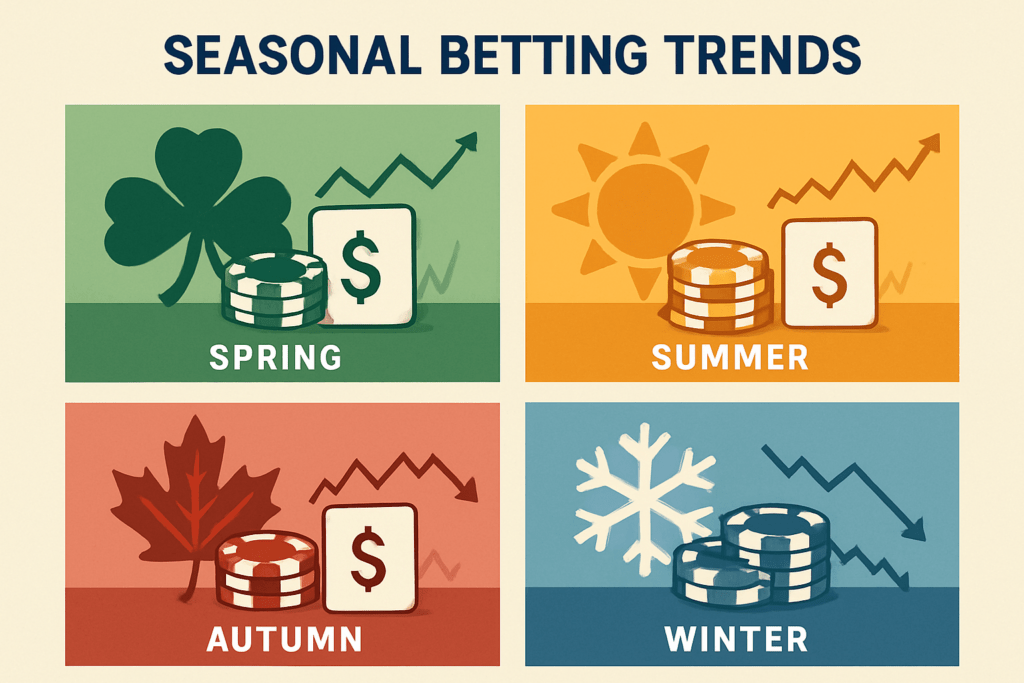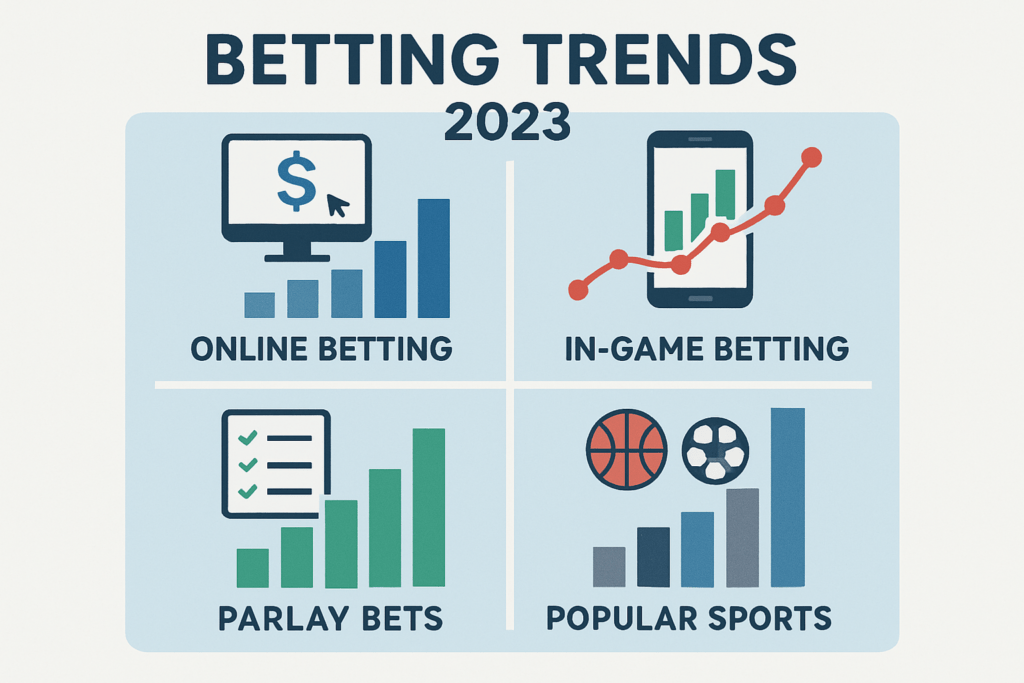Seasonal Betting Trends: How to Capitalize on Them
Seasonal Betting Trends: How to Capitalize on Them
Catching seasonal betting trends isn’t about some secret system—it’s about keeping your eyes open and your bets focused when everyone else is sleeping at the wheel. Most people bet on autopilot; smart bettors understand that the “when” is often as important as the “what.” Want proof? Look at how lines shift right before major holidays, how public money rushes in during playoff time, or how quiet weeks throw off bookmaker algorithms. These are real, recurring patterns—not just random noise.
Every season brings its quirks. NFL in the fall? Suddenly, sportsbooks flood with recreational money, which means lines move in odd ways. March Madness? More eyes, more bets, more chaos—ripe for picking off mistakes. And don’t forget the “dead” spots, like late summer baseball or post-holiday NBA games, where casual bettors disappear and sharp money quietly shapes the numbers.
Bottom line: Betting’s not just about picking teams—it’s about picking your spots. Seasonal trends can tip the odds in your favor, but only if you’re willing to track the calendar, spot when markets get lazy, and strike when the time’s right. Ignore the clock, and you’re just another fish in the betting pool. Pay attention, and you might just turn those subtle market shifts into cold, hard profit.
Why Seasons Matter in Betting
Let’s get this straight: betting isn’t just cold numbers and gut feelings. It’s timing, too. Seasons mess with everything—team rosters, motivation, even the way a sport is played. Take the NFL: late-season games in freezing temps aren’t the same as breezy September matchups. Basketball teams? Often gassed in back-to-backs as the season wears on. Bookmakers know this and shift their odds. Most casual bettors don’t notice. That’s your angle.
Seasonal betting trends aren’t always obvious. Sometimes it’s new managers in baseball come spring. Sometimes it’s soccer teams fighting relegation in April playing with a desperation unseen in autumn. The calendar shapes schedules, but it also shapes narrative and psychology.
Bottom line: if you’re betting the same way every week, you’re leaving money on the table. Smart bettors hunt for these seasonal quirks—slower games, surprise upsets, streaks. Know when they hit, and suddenly, you’re not just a fan playing along. You’re a shark with teeth.
Breaking Down Seasonal Gambling Adjustments
Sports don’t play on a flat line. The calendar swerves: playoffs hit, major tournaments catch fire, and then… those deadzones when action is sparse. Bookmakers know the pulse. When demand surges for, say, Super Bowl weekend or March Madness, limits get tighter, odds defenses get fierce, and bonus offers dry up—or sometimes spike as bait for casuals. During the off-season, books relax. Odds might drift, promos appear, and limits widen to attract traffic.
You’ve got to see the game inside the game. Higher betting volumes mean sharper odds and faster line movement. Off-season? Sometimes softer lines sneak through while books focus attention elsewhere. The sharpest bettors anticipate these environmental changes—not just reacting, but planning before the public tips the scale. In short: know the rhythm, and you’ll spot edges hiding between the headlines.
The Weather Factor
Weather isn’t just small talk for bettors—it’s a live wire in the heart of betting strategy. Every sharp knows a clear sky isn’t the same as a downpour. Take the NFL: snow dumps on the field, suddenly passing games stall and the “under” starts looking juicy. In soccer, a scorching day can slow the pace, favoring gritty underdogs and dampening goal totals. And at the racetrack? Wind direction can turn a front-runner into a lost cause.
It’s not about chasing every forecast—just spotting when the market isn’t paying attention. Injuries tick up when conditions turn ugly. Scoring trends skew. Favorites falter. Sometimes, bookmakers overcorrect based on weather headlines; other times, they miss it entirely. Your job? Cut through the hype, trust the data, and bet where the edge lives—in those margins others skip. Weather isn’t noise. It’s opportunity, if you’re paying attention.
Spotting Seasonal Opportunities
Sharp bettors don’t just wait for big hype events—they circle the calendar and look for the sweet spots. March Madness gets headlines, but maybe there’s more value in summer baseball games, or early rounds in winter sports when sportsbooks are stretched thin. When mainstream action slows down, lines often get softer. This is where you hunt: “dead” periods, weird sports windows, and those weeks when everyone else is distracted.
Don’t mindlessly bet what everyone else is betting. Zoom out: maybe Aussie Rules Football is heating up when your usual market goes dull. Is everyone focused on Champions League? Maybe MLS has pricing errors. Markets move in cycles, just like the seasons. Know when and where the action shifts, and you’ll often find yourself one step ahead.
Technology’s Role in Seasonal Betting
Forget scanning newspapers and gut calls—tech now rules the seasonal betting game. With real-time data feeds, modeling tools, and line trackers, you can spot trends and shifts before the masses even notice. Think it’s too complex? Not really. Even with entry-level apps, you can monitor betting volumes and historical outcomes in seconds. Most top-tier sportsbooks offer dashboards showing line movement and sharp money. Cross-check this with weather APIs or injury trackers, and you’ve got an edge that’s about speed, not just smarts.
Let’s be blunt: those who rely on memory or “feel” get left behind. Automation algorithms don’t get tired. Machine learning models can alert you when a line’s about to swing based on past seasonal volatility. That means you’re jumping on value picks, not chasing steam.
Bottom line: plug into tech, build a habit of checking data before every wager, and watch your seasonal game tighten up. For a deeper dive, check out our piece on technology’s role in shaping modern betting trends.
Real-World Examples: Turning Trends Into Profit
Let’s get specific. In 2022, a cold front swept through the Northeast just as the NFL playoffs kicked off. Sharp bettors who tracked radar apps noticed totals dropped by several points on game day. Those who grabbed unders early—before lines adjusted—cleaned up. The books caught on, but not before savvy players banked some easy wins.
Soccer’s a different beast. Every summer, top European leagues go on break, but some fixtures—and friendlies—stay on the board. During these “dead” periods, draw results quietly spike, especially in matches between evenly matched teams lacking motivation. Bookmakers, distracted by lower volume, sometimes offer softer lines. Those hunting for value cleaned up by riding the draw wave.
Baseball tells its own seasonal story. In July and August, pitching depth gets exposed. Favorites that crushed in May can start crumbling in the heat, especially if their bullpen’s gassed or a heatwave rolls in. In 2023, underdogs cashed at a noticeably higher rate in some MLB divisions during these months. Bettors who paid attention—not to hype, but to matchups and weather—saw the profits add up.
Bottom line: these trends aren’t “get rich quick” hacks, but they’re real. Stay sharp, study the shifts, and you’ll find edges when others aren’t looking.
Your Playbook: Step-by-Step
- Watch the Calendar: This sounds basic, but it’s easy to forget. Map out the sports year. Lock in on when leagues kick off, hit playoffs, or go into hibernation. Those shifts? That’s where lines and volumes get weird. Take notes.
- Check the Weather: You don’t need a meteorology degree. Just know that snow, rain, or sweltering heat will shift game script and, sometimes, betting value. Look at weather apps or news. It’s straightforward, high-upside info.
- Track the Public: Pay attention to where the action is pouring in. When casual money floods a market—think big tournaments or wild upsets—lines can drift. Don’t chase, but spot overreactions and play the other side.
- Diversify: Seasons change, so should you. Don’t cling to one sport if it’s off-season or the lines are tight. Try niche leagues, alternate markets, or just hit pause. Cold streaks happen—forcing bets in dead zones is a rookie move.
Bottom line: treat betting like a season—ebb and flow, adapt and survive. The sharpest edge? Knowing when to push, and when to wait.
Where to Get More Insights & Data
Information is leverage. Reliable data is everywhere now, but not all sources are created equal. Stick with sites that update regularly and provide actual analysis—trend trackers like Oddschecker or sites with historical odds archives are a good start. Social platforms can give you a pulse on public opinion (and sometimes public mistakes), but don’t build your whole strategy off chatter.
For seasonal specifics, dive into betting forums during different times of year and note how the conversation shifts. Make a habit of checking out odd movement charts—they’re not glamorous, but they lay out when markets heat up or cool off. Third-party tools and apps can crunch a lot of this automatically if you prefer.
Bottom line: Don’t rely on word-of-mouth or vague “hot tips.” Build up your own shortlist of trusted sources, cross-check them, and always keep one eye open for new trend reports or seasonal studies. Data never sleeps, and neither should your edge.
Conclusion
Seasonal betting trends aren’t just trivia—they’re a roadmap for the smart, adaptive bettor. The difference between luck and lasting profit is often as simple as paying attention to the calendar and making the right adjustments. Don’t chase every bet. Instead, make small tweaks, track your results, and look for those hidden advantages that come around each season.
Over time, these little edges add up. The best bettors aren’t psychic—just people who know how to read the “seasons” better than most. Stay curious, stay disciplined, and use what you’ve learned to keep your bankroll healthy all year round.



